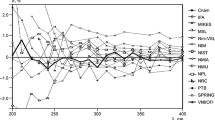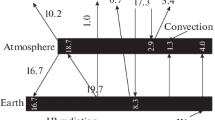Summary
Values of infrared transmission by water vapour are required in order to prepare radiation charts, to establish electronic computer programs for flux calculations, to permit deduction of stratospheric vapour concentrations from infrared observations and to facilitate the interpretation of infrared satellite data. In this paper, approaches involving the extensive use of spectroscopic (and theoretically derived) parameters are explored fully and their limitations indicated.
The central problem in the use of the random model for the water vapour spectrum is the choice of a suitable unit of spectral interval. This choice involves the testing of line positions for a random distribution, the combination or separation of closely-adjacent lines and the assessment of the effects of a variable band envelope. Techniques suitable for these purposes are developed. In the spectral region between bands, one must consider the background or continuous absorption due to distant but strong lines. Appropriate methods of doing this are presented. In this case, in particular, the calculation of flux transmission for non-homogeneous atmospheric slabs presents special problems, which are considered here.
Zusammenfassung
Für die Konstruktion von Strahlungsdiagrammen, die Erstellung von Programmen für die Berechnung von Strahlungsströmen mittels elektronischer Rechenmaschinen, für die Ermittlung von Wasserdampfkonzentrationen in der Stratosphäre durch Infrarotbeobachtungen und für die Auswertung von Strahlungsdaten, die von Satelliten gewonnen werden, sind genaue Angaben über die langwellige Transmission des Wasserdampfes erforderlich. In der vorliegenden Arbeit wird der Versuch unternommen, durch umfassenden Gebrauch von spektroskopischen (und auch theoretischen) Parametern diese Aufgabe zu lösen, wobei, auch die Grenzen der Methode aufgezeigt werden.
Das Kernproblem bei der Verwendung eines Zufallsmodells des Wasserdampfspektrums ist die Wahl einer geeigneten Einheit für die Spektralintervalle. Dies bedeutet eine Überprüfung der Lage der Absorptionslinien im Hinblick auf eine Zufallsverteilung, die Vereinigung oder Trennung benachbarter Spektrallinien und die Beurteilung der Frage, inwieweit die Wahl verschiedener Einhüllender der Spektralbanden das Ergebnis beeinflußt. Es wurden dafür geeignete Methoden entwickelt. In den Spektralbereichen zwischen den Banden muß auch der Betrag der kontinuierlichen Absorption, hervorgerufen durch die auseinanderliegenden, aber starken Linien in Rechnung gestellt werden. In diesem Fall ergibt sich das besondere Problem, die Strahlungsströme für nicht homogene Atmosphärenschichten zu berechnen.
Résumé
Il est indispensable de posséder des données exactes de la transmission pour les longues ondes dans la vapeur d'eau pour l'étude des domaines suivants: construction de diagrammes du rayonnement, programmation pour le calcul des flux de rayonnements par des calculatrices électroniques, calcul du taux de vapeur d'eau dans la stratosphère par des observations dans l'infra-rouge, dépouillement des données du rayonnement fournies par les satellites artificiels. Le présent travail est un essai de solution de ce problème au moyen de paramètres spectroscopiques et théoriques; on y indique cependant aussi les limites utiles de la méthode.
Lors de l'utilisation d'un modèle aléatoire du spectre de la vapeur d'eau, le problème crucial est le choix d'une unité adéquate pour la mesure des intervalles spectraux. Cela implique l'examen de la position des lignes d'absorption en rapport avec la répartition aléatoire, la réunion ou la séparation de lignes spectrales rapprochées et l'appréciation de la mesure dans laquelle le résultat est influencé par le choix des différentes enveloppantes des bandes spectrales. On a développé des méthodes appropriées à ce but. La valeur de l'absorption continue, provoquée par des lignes distinctes, mais fortement marquées doit également être prise en considération dans l'espace compris entre les bandes du spectre. Dans ce cas, il se pose un problème particulier: celui du calcul des flux de rayonnement pour des couches atmosphériques inhomogènes.
Similar content being viewed by others
References
Elsasser, W. M.: Heat Transfer by Infrared Radiation in the Atmosphere. Harvard Met. Studies No. 6 (1942).
Yamamoto, G.: On a Radiation Chart. Sci. Rep. Tohoku Univ. Ser. 5 (Geophys.)4, 9–23 (1952).
Goody, R. M.: A Statistical Model for Water-vapour Absorption. Quart. J. Roy. Met. Soc.78, 165–169 (1952).
Kaplan, L. D.: A Quasi-statistical Approach to the Calculation of Atmospheric Transmission. Proc. Toronto Met. Conf. 1953, 43–48 (1954).
Godson, W. L.: The Computation of Infrared Transmission by Atmospheric Water Vapor. J. Met.12, 272–284 (1955).
Godson, W. L.: Spectral Models and the Properties of Transmission Functions. Proc. Toronto Met. Conf. 1953, 35–42 (1954).
Godson, W. L.: The Computation of Infrared Transmission by Atmospheric Water Vapor, Part II. J. Met.12, 533–535 (1955).
Yamamoto, G., andT. Sasamori: Numerical Study of Water Vapour Transmission. Sci. Rep. Tohoku Univ. Ser. 5 (Geophys.)8, 36–45 (1957).
Benedict, W. S., andL. D. Kaplan: Calculation of Line Widths in H2ON2 Collisions. J. Chem. Phys.30, 388–399 (1959).
Benedict, W. S., H. H. Claassen, andJ. H. Shaw: Absorption Spectrum of Water Vapor between 4.5 and 13 Microns. J. Res. Nat. Bur. Stand.49, 91–132 (1952).
Cowling, T. G.: Atmospheric Absorption of Heat Radiation by Water Vapour. Phil. Mag. Ser. 741, 109–123 (1950).
Author information
Authors and Affiliations
Additional information
With 4 Figures
Published by permission of the Director, Meteorological Branch, Department of Transport, Canada, and dedicated toDr. W. Mörikofer on the occasion of his 70th birthday.
Rights and permissions
About this article
Cite this article
Godson, W.L. Infrared transmission by water vapour. Arch. Met. Geoph. Biokl. B. 12, 1–18 (1962). https://doi.org/10.1007/BF02317949
Issue Date:
DOI: https://doi.org/10.1007/BF02317949




